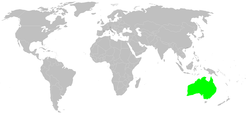Phryganoporus candidus
| Phryganoporus candidus | |
|---|---|
| Scientific classification | |
| Kingdom: | Animalia |
| Phylum: | Arthropoda |
| Class: | Arachnida |
| Order: | Araneae |
| Suborder: | Araneomorphae |
| Family: | Desidae |
| Genus: | Phryganoporus |
| Species: | P. candidus |
| Binomial name | |
| Phryganoporus candidus (L. Koch, 1872) | |
| Species | |
|
See text. | |
 | |
Phryganoporus candidus, sometimes called the foliage webbing spider, is a spider widespread, but endemic in Australia. It is up to 10 mm long, silvery grey to brown with a pattern of light and dark brown markings on the abdomen. Unlike most other spiders, P. candidus lives socially at one stage: Spiderlings live together in a nest built on foliage until they reach the subadult stage. The males even stay into the adult stage and only then leave. This communal nest has an inner retreat area, many entrance holes opening into a network of interconnecting passages, and an outer area made out of cribellate silk for prey capture. One nest can in extreme cases house more than 600 spiders. Nests of this size attract many arthropod parasites. The species name is derived from Latin candidus "shining white", referring to the color of the legs.
References
- Platnick, Norman I. (2009): The world spider catalog, version 9.5. American Museum of Natural History.